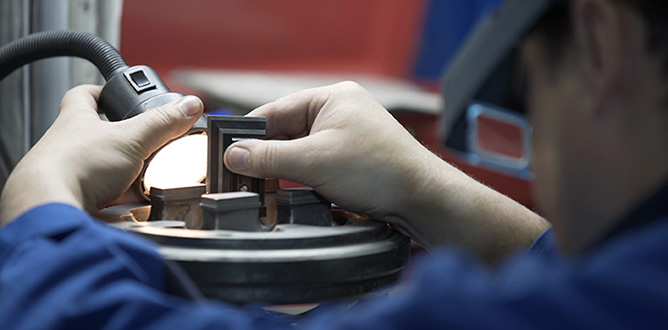Insight
Published and updated
Converting Inputs into Outputs: 5 Ways to Ensure Productivity and Cost Control

Productivity is the universal yardstick that shows how adept a manufacturer is at using resources to produce goods. Employing key and seemingly simple measures make for efficient and cost-effective operations – whether it’s standardizing a process or extending a worker’s reach by implementing a communication solution that offers hands-free, simultaneous two-way conversation.
STANDARDIZE EVERY STEP
We all have our own perspective on how to accomplish our work, but in manufacturing, having uniformity in even the simplest tasks is the way to go. When all the cooks are using the same recipe, the cake turns out the same every time.
To check for standardization in your workplace, form a task force whose goal is to develop a streamlined list of what needs to be accomplished at each work station or cell. Include all tools and equipment used. A deeper dive into the “what” and the “why” usually leads to great discussions about an ideal order of operations and a refined process.
MAKE TRAINING EASY AND EFFECTIVE
While all organizations offer some form of training to bring new hires up to speed or to implement new processes, make sure it’s formally documented and properly rolled out to ensure everyone’s meeting the same requirements. This doesn’t have to be a big deal requiring a ton of resources.
Have your trainers reference the standards that you came up with earlier. Whether you’re covering proficiency in the use of hand tools or how to interface with automated equipment via a touch screen, every employee will be current on receiving the right instruction and certifications.
Extend the reach: cross-train 50% of your employees on adjacent workstations. A wider pool of available operators makes for a more flexible workforce and can compensate for unexpected absenteeism. Also, expanded workstation rotation gives workers a broader view of the process they’re involved in so they better understand their role in the final product.
HAVE A RUNNING LIST
Needs don’t stop evolving once you’ve implemented some training. Here’s a production manager’s approach: keep an ongoing list of pain points at work. Focus on barriers to output or the anchors that drag down your teams’ time and resources.
This one’s a cognitive strategy. Our subconscious brain can churn ideas and experiment with fresh approaches to age-old issues as we move through our days and weeks. Who hasn’t had an “Aha!” moment while doing something completely disconnected, like driving to the store?
The goal is to get more clarity on exactly what the problem is in order to implement the right solution. That clarity helps avoid the ready-fire-aim strategy. For example, assigning overtime in order to get more product out the door is doomed to be less effective if there’s an ongoing bottleneck caused by unscheduled equipment maintenance.
ADOPT NEW TECHNOLOGY
Wait – what about controlling costs? Adopting new technology is not about open-ended spending. Strategic decisions based on a solid return on investment that include direct and indirect benefits can improve your competitive advantage. Time and money saved, improved personal safety and higher morale are real game-changers for any manufacturer.
New technology doesn’t have to be cutting-edge machinery or touch-screen monitors everywhere you look. It can represent any value-add in your organization. Upgrading overhead lighting to motion-activated LED’s has been an option for decades. Wireless headsets that allow you to communicate hands-free can be implemented easily so you don’t have to stop work or shut down equipment. Implementing the right technology can bring about some obvious and immediate benefits.
TAP INTO WORKER EXPERTISE
Your floor workers are more experienced in the production process than anyone in the building. Ask and they’ll quickly share three small tweaks that’ll reduce cycle time or waste.
Set up an easy way to encourage idea generation for changes to the lines – a process for change. Call it PFC for short. It could be as simple as an email template with a few fields to fill out that explain an issue, a solution and its advantages. Press SEND and the email goes to a review board who’ll evaluate and discuss submitted ideas. Limited access to computers? Go old-school and use slips of paper and a suggestion box.
Tip: Keep the feedback loop going and communicate back to the idea’s originator. Clear reasoning promotes engagement and we all appreciate recognition of our efforts.
SONETICS IS A KEY CONTRIBUTOR TO THE VALUE CHAIN
It is all about effective communication, and it impacts productivity in all areas of your manufacturing facility.
When everyone is able to hear and talk naturally, interactions happen more often. Your team is able to share issues in real-time and coordinate a corrective response. The lines stay up and your downstream partners are aware of what’s happening. Problems solved.
Find out how Sonetics Wireless Headsets can help improve your team’s productivity and reduce downtime.